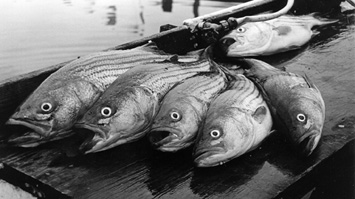
Dock of the Bay

Volume VI Number 16
April 23-29, 1998
On Opening Day, Too Many Fish in the Bay?
Signs point to an abundant rockfish season. "Excellent," says Capt. George Prenant, below, and other fish-catchers. Yet questions remained about the health of the baitfish population that feeds striped bass.
A rockfish lurking in a pound net near Deale the other day burdened the scale at 50 pounds before being sent on its way.
A scouting expedition out of Chesapeake Beach found 15 rockfish in short
order; 12 were keepers - a liberalized 28 inches this spring.
In West River, everything that charter Capt. Joe Richardson has seen suggests an Opening Day April 24 as bountiful as he found a year ago near Bloody Point.
"By 9am, we had our six keepers. I never even got off the back deck to get a cup of coffee," said Richardson, who runs Dancer, a 37-foot Post sportfisher.
At the dawn of the new striped bass season, just about everybody who spends time on the Bay had a story suggesting that a heart-thumping, arm-aching season of fine fishing lies ahead.
Pfiesteria hasn't raised its frightful mug, scaring away weekend trollers. Conditions seem right for a huge spawn, which has begun. New fishing-friendly limits will assure that more fish will be caught, perhaps a lot more. If there's a problem with rockfish, it may be that there's too many in the Bay for the food and habitat available.
First, you need to be clear on the rules of the game.
The drop from 32 inches to 28 during the trophy season is especially welcome to Chesapeake Beach charter captain Bert Shaffner.
"Last year, I was measuring [and throwing back] a lot of fish that were 3112 or 3134. I think people will have more fun this year," said Shaffner, who operates Feathers, a 38-foot Delta built for off-shore fishing.
Capt. George Prenant, whose Stormy Petrel charter often serves as a beacon for mid-Bay fish-hunters, says he's not too worried about the abundance of fresh water from the rainy winter and early spring.
For Prenant, the relaxed size limit means early season chumming in June
and July, which translates to more light tackle and more action for members
of his parties.
The new rockfish season seems sure to produce many fish. Less certain is whether it will produce answers to questions that have popped up in these times of plenty.
By some counts, one in 10 rockfish taken last year had minor skin infections that were unrelated to the Pfiesteria microbe but suggested nutritional problems. Is the Bay's declining population of menhaden, alewives and other baitfish beginning to take a toll on rockfish?
Bill Goldsborough, fisheries expert at the Chesapeake Bay Foundation, believes there may be too little food for too many fish.
"This takes us into a new realm of striped bass and fisheries in general," said Goldsborough. "I would suggest that these circumstances might not have happened had we not compromised the fish habitat in the Bay - the sea grass beds and the oyster reefs."
A shortage of baitfish means mounting pressure for a political solution to limiting the huge, commercial menhaden fishery at the mouth of the Chesapeake. The Atlantic Menhaden Advisory Committee met last week to step up the pace of finding answers.
Those battles lie ahead. For now, on the eve of the '98 rockfish season, the signs pointed to a season that Capt. Prenant, not a man for overstatement, predicts will be "excellent."
Here's how to reach charterboat captains quoted in this story: Capt. Prenant: 301/261-9075; Capt. Richardson: 410/798-6419; Capt. Shaffner: 301/855-8450.
-BL
In Our Neighborhoods:Cedar Grove Church Grows by Pains & Miracles
A Deale landmark for 106 years is going through growing pains - again. That growth has been marked by at least one miracle, or so we're told by congregants of Cedar Grove United Methodist Church.
On April 26, the church dedicates its new Education Center, the old Deale
Community Hall, while it worships in its Fellowship Hall and wrestles with
plans to replace its 86-year-old sanctuary.
That plan has led some members of the church to leave, fearing that the familiar building they visited as children will be torn down.
"We're not trying to keep anybody out. We're trying to invite them in. We need them. God wants them here," replies the pastor, the Rev. Kevin M. Baker.
The small buildings are a blessing rather than a problem, asserted Jim Stafford, chairman of the Building Committee. "The Lord has drawn people into this church, and we don't have room for them," he said.
"Three years ago we needed seats for 125 people. Now we need 350 seats."
The recent "miracle" created the congregation's new Education Center, as the story goes. Born in 1947 as the Deale Community Center, the cinder-block, brick-faced building later become a Lions Club. It was bought by the neighboring Cedar Grove Church in the early 1980s, and in recent years served as Anne Arundel County's Food Bank for South County.
Now it's part of the church's game of musical buildings. Cedar Grove first renovated its fellowship hall and occupied that structure as a temporary sanctuary. Then work began to repair the free-standing old community center and prepare it for use as a fellowship and education center. Leaks were discovered in the roof.
"We needed $19,000," said Pastor Baker. And quickly, since the work was under contract.
He urged his congregation to pray about whether to repair the leaking roof. If they were going to build a new pitched roof, they'd have to come up with the money at a special offering the following Sunday.
The next evening, the envelopes were opened. Checks and cash fell out onto the table.
"The electricity in that room was thicker than pea soup," said Stafford.
There was $30,000 in the collection plate.
The roof fund grew to $43,000 when a donated stock increased in value.
As for the old sanctuary, which has been declared by engineers as structurally dangerous, work goes on to raise the $600,000 to $700,000 needed to replace it.
"We're pressing forward, hearing and compiling ideas and keeping the blinders off, praying the Lord will provide us with the answers," Stafford said.
Discontent has focused not so much on tearing down the old church and replacing it with a larger church, as happened before in 1912, but more on the loss of memories tied to the old sanctuary.
Former church historian George Stringer, of Masons Beach, said that Cedar Grove started its life as Oakland United Methodist Church on Chalk Point Road. In 1898, Oakland built a new church and gave its clapboard building to the founders of Cedar Grove. It was hauled by ox carts to a half acre called "Gotts Swamp," donated by Thomas and Mary Deale and located on the corners of Deale-Churchton and Masons Beach roads.
The church was formally organized after an 1892 revival service in a barn loaned by Miss Zepporah Deale resulted in 42 conversions.
"It's been there for our lifetimes," Stringer said of Cedar Grove.
-Val Hymes
If This Is Spring, Those Are Peepers
photo courtesy of Jug Bay Wetlands Sanctuary
Spring, traditionally the season of love and romance, is here once again.
And not just for humans.
As many a sleep-deprived listener can attest, the spring peepers have
set about sounding their siren song. Ov er the two-month period between early March and late April, these
little Casanovas reach their peak. Every night they congregate in unseen
but easily heard locations to call out for potential mates.
er the two-month period between early March and late April, these
little Casanovas reach their peak. Every night they congregate in unseen
but easily heard locations to call out for potential mates.
And we hear it. It's loud. Their calls surround us from the Gulf of Mexico to Canada's Southern Tier, from the Atlantic out west toward the Mississippi. However, despite their obvious large numbers and close proximity to us humans, many of us don't know what we're hearing.
Prepare to be enlightened. The spring peeper, or Pseudacris crucifer, is a small tree frog. On average a peeper measures about one inch in length. The crucifer in their scientific name stands for the cross-like X on their back. As their range of habitat and decibel level indicate, peepers are a successful group; in fact, they are one of the most successful frogs. Good for them perhaps, but not so good if you're a light sleeper.
Spring peepers become most active about two hours after sunset, when they descend from their treetop abodes to collect in woodland pools.
Just how many might I find in my woodland pool? "Oh my goodness, thousands and thousands," said Andy Brown of Battle Creek Cypress Swamp Nature Center.
Dating pools this large would cause even the ancient Romans to blush.
Though El Niño gave us a wetter and warmer winter than usual, Brown estimates that the peeper population has seen no significant change. Spring peepers have a very stable population, with a high reproduction rate offset by extensive predation. In turn, spring peepers play a very important ecosystem role as a food source.
Peepers also serve as excellent measuring sticks for pollution. Amphibians overall are very sensitive to chemicals, absorbing them easily through their soft skins. As Brown put it, "They can be environmental indicators, like a canary in a coal mine." So scientists monitor pollutant levels by monitoring the population of frogs. These peepers actually have a role in the scheme of things.
If you are among the sleepless, you may be happy to know that the amorous season has passed its peak. In time, only the true romantics will remain in the pools, peeping lovely ballads to the objects of their affection.
But don't count your tadpoles before they've hatched. As Mike Quinlan, a volunteer at Jug Bay Wetland Sanctuary, suggests some may return whenever it gets warm, even in the winter.
But does love really have a season?
-Mark Burns
In the Everglades rain-filled marshes, a recent count showed an 83 percent drop in the number of herons, egrets, ibis and wood storks since last year. The dwindling numbers are blamed on El Niño-spawned rains - and the Army Corps of Engineers, which has refused to drop water levels. One of the Corps' reasons is that engineers wanted to protect a group of nesting sparrows
Japan's whaling industry is none too popular among fish conservationists these days. Whalers returned to port from Antarctica this month with 440 minke whales despite an international whaling band and a drive to designate Antarctica a whale sanctuary. The World Wildlife Fund reported that some of the meat will be used in school lunches "to foster the taste for whale meat amongst children"
In Utah, actor Robert Redford is walking
the walk when it comes to conservation. He donated 859 acres of wildlife
habitat and alpine meadows near  Sundance
to the Utah Open Lands for preservation ...
Sundance
to the Utah Open Lands for preservation ...
In India, energy expert P.K. Jha has an idea that's not too appealing. He was reported by Africa News Online to be advocating the use of human waste in developing countries facing energy shortages. Jha said that new technology allows, for instance, the ability to "cook very nice food"
Our Creature Feature this week comes to us from Alabama where you may want to travel for the National Skunk Show. But you'll need to mark your calendar for next April because this year's just ended.
No, you won't have to worry about people knowing where you visited, like people returning from France with French perfume; these creatures are de-scented. But they have other distinguishing characteristics - their markings and personality. They're not overly bred, either, to make the perfect skunk. Jane Bone, of Skunks as Pets, told the Birmingham Post why:
"We don't want snobs owning skunks. We want you to own a skunk because you love one."
| Back to Archives |
Volume VI Number 16
April 23-29, 1998
New Bay Times
| Homepage |